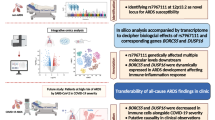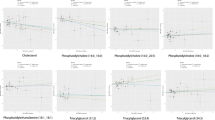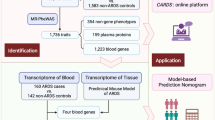Abstract
This study was conducted to establish the possible contribution of functional gene polymorphisms in detoxification/oxidative stress and vascular remodeling pathways to community-acquired pneumonia (CAP) susceptibility in the case–control study (350 CAP patients, 432 control subjects) and to predisposition to the development of CAP complications in the prospective study. All subjects were genotyped for 16 polymorphic variants in the 14 genes of xenobiotics detoxification CYP1A1, AhR, GSTM1, GSTT1, ABCB1, redox-status SOD2, CAT, GCLC, and vascular homeostasis ACE, AGT, AGTR1, NOS3, MTHFR, VEGFα. Risk of pulmonary complications (PC) in the single locus analysis was associated with CYP1A1, GCLC and AGTR1 genes. Extra PC (toxic shock syndrome and myocarditis) were not associated with these genes. We evaluated gene–gene interactions using multi-factor dimensionality reduction, and cumulative gene risk score approaches. The final model which included >5 risk alleles in the CYP1A1 (rs2606345, rs4646903, rs1048943), GCLC, AGT, and AGTR1 genes was associated with pleuritis, empyema, acute respiratory distress syndrome, all PC and acute respiratory failure (ARF). We considered CYP1A1, GCLC, AGT, AGTR1 gene set using Set Distiller mode implemented in GeneDecks for discovering gene-set relations via the degree of sharing descriptors within a given gene set. N-acetylcysteine and oxygen were defined by Set Distiller as the best descriptors for the gene set associated in the present study with PC and ARF. Results of the study are in line with literature data and suggest that genetically determined oxidative stress exacerbation may contribute to the progression of lung inflammation.

Similar content being viewed by others
References
Wunderink RG, Waterer GW (2005) Genetics of community-acquired pneumonia. Semin Respir Crit Care Med 25:553e62
Waterer GW, Quasney MW, Cantor RM, Wunderink RG (2001) Septic shock and respiratory failure in community-acquired pneumonia have different TNF polymorphism associations. Am J Respir Crit Care Med 163(7):1599–1604
Morimoto S, Okaishi K, Onishi M, Katsuya T, Yang J, Okuro M, Sakurai S, Onishi T, Ogihara T (2002) Deletion allele of the angiotensin-converting enzyme gene as a risk factor for pneumonia in elderly patients. Am J Med 112(2):89–94
Wunderink RG, Waterer GW, Cantor RM, Quasney MW (2002) Tumor necrosis factor gene polymorphisms and the variable presentation and outcome of community-acquired pneumonia. Chest 121(3 Suppl):87S
Gallagher PM, Lowe G, Fitzgerald T, Bella A, Greene CM, McElvaney NG, O’Neill SJ (2003) Association of IL-10 polymorphism with severity of illness in community acquired pneumonia. Thorax 58(2):154–156
Gentile DA, Doyle WJ, Zeevi A, Howe-Adams J, Kapadia S, Trecki J, Skoner DP (2003) Cytokine gene polymorphisms moderate illness severity in infants with respiratory syncytial virus infection. Hum Immunol 64(3):338–344
Gomi K, Tokue Y, Kobayashi T, Takahashi H, Watanabe A, Fujita T, Nukiwa T (2004) Mannose-binding lectin gene polymorphism is a modulating factor in repeated respiratory infections. Chest 126(1):95–99
Schaaf B, Rupp J, Müller-Steinhardt M, Kruse J, Boehmke F, Maass M, Zabel P, Dalhoff K (2005) The interleukin-6-174 promoter polymorphism is associated with extrapulmonary bacterial dissemination in Streptococcus pneumoniae infection. Cytokine 31(4):324–328
Takahashi T, Morimoto S, Okaishi K, Kanda T, Nakahashi T, Okuro M, Murai H, Nishimura Y, Iwai K, Matsumoto M (2005) Reduction of pneumonia risk by an angiotensin I-converting enzyme inhibitor in elderly Japanese patients according to insertion/deletion polymorphism of the angiotensin I-converting enzyme gene. Am J Hypertens 18(10):1353–1359
Yende S, Angus DC, Ding J, Newman AB, Kellum JA, Li R, Ferrell RE, Zmuda J, Kritchevsky SB, Harris TB, Garcia M, Yaffe K, Wunderink RG, Health ABC Study (2007) 4G/5G plasminogen activator inhibitor-1 polymorphisms and haplotypes are associated with pneumonia. Am J Respir Crit Care Med 176(11):1129–3117
Endeman H, Herpers BL, de Jong BA, Voorn GP, Grutters JC, van Velzen-Blad H, Biesma DH (2008) Mannose-binding lectin genotypes in susceptibility to community-acquired pneumonia. Chest 134(6):1135–1140
Garcia-Laorden MI, Sole-Violan J, Rodriguez de Castro F, Aspa J, Briones ML, Garcia-Saavedra A, Rajas O, Blanquer J, Caballero-Hidalgo A, Marcos-Ramos JA, Hernandez-Lopez J, Rodriguez-Gallego C (2008) Mannose-binding lectin and mannose-binding lectin-associated serine protease 2 in susceptibility, severity, and outcome of pneumonia in adults. J Allergy Clin Immunol 122(2):368–374
van de Garde EM, Endeman H, Deneer VH, Biesma DH, Sayed-Tabatabaei FA, Ruven HJ, Leufkens HG, van den Bosch JM (2008) Angiotensin-converting enzyme insertion/deletion polymorphism and risk and outcome of pneumonia. Chest 133(1):220–225
Yuan FF, Marks K, Wong M, Watson S, de Leon E, McIntyre PB, Sullivan JS (2008) Clinical relevance of TLR2, TLR4, CD14 and FcgammaRIIA gene polymorphisms in Streptococcus pneumoniae infection. Immunol Cell Biol 86:268–270
Endeman H, Cornips MC, Grutters JC, van den Bosch JM, Ruven HJ, van Velzen-Blad H, Rijkers GT, Biesma DH (2009) The Fcγ receptor IIA-R/R131 genotype is associated with severe sepsis in community-acquired pneumonia. Clin Vaccine Immunol 16(7):1087–1090
Herpers BL, Endeman H, de Jong BA, de Jongh BM, Grutters JC, Biesma DH, van Velzen-Blad H (2009) Acute-phase responsiveness of mannose-binding lectin in community-acquired pneumonia is highly dependent upon MBL2 genotypes. Clin Exp Immunol 156(3):488–494
Mukamal KJ, Pai JK, O’Meara ES, Tracy RP, Psaty BM, Kuller LH, Newman AB, Yende S, Curhan GC, Siscovick DS, Rimm EB (2010) CRP gene variation and risk of community-acquired pneumonia. Respirology 15(1):160–164
Solé-Violán J, de Castro Fv, García-Laorden MI, Blanquer J, Aspa J, Borderías L, Briones ML, Rajas O, Carrondo IM, Marcos-Ramos JA, Ferrer Agüero JM, Garcia-Saavedra A, Fiuza MD, Caballero-Hidalgo A, Rodriguez-Gallego C (2010) Genetic variability in the severity and outcome of community-acquired pneumonia. Respir Med 104(3):440–447
Solé-Violán J, García-Laorden MI, Marcos-Ramos JA, de Castro FR, Rajas O, Borderías L, Briones ML, Herrera-Ramos E, Blanquer J, Aspa J, Florido Y, García-Bello MA, Ferrer-Agüero JM, Sologuren I, Rodriguez-Gallego C (2011) The Fcγ receptor IIA-H/H131 genotype is associated with bacteremia in pneumococcal community-acquired pneumonia. Crit Care Med 39(6):1388–1393
Endeman H, Meijvis SC, Rijkers GT, van Velzen-Blad H, van Moorsel CH, Grutters JC, Biesma DH (2011) Systemic cytokine response in patients with community-acquired pneumonia. Eur Respir J 37:1431–1438
García-Laorden MI, Rodríguez de Castro F, Solé-Violán J, Rajas O, Blanquer J, Borderías L, Aspa J, Briones ML, Saavedra P, Marcos-Ramos JA, González-Quevedo N, Sologuren I, Herrera-Ramos E, Ferrer JM, Rello J, Rodríguez-Gallego C (2011) Influence of genetic variability at the surfactant proteins A and D in community-acquired pneumonia: a prospective, observational, genetic study. Crit Care 15(1):R57
Lingappa JR, Dumitrescu L, Zimmer SM, Lynfield R, McNicholl JM, Messonnier NE, Whitney CG, Crawford DC (2011) Identifying host genetic risk factors in the context of public health surveillance for invasive pneumococcal disease. PLoS One 6(8):e23413
Martín-Loeches I, Solé-Violán J, Rodríguez de Castro F, García-Laorden MI, Borderías L, Blanquer J, Rajas O, Briones ML, Aspa J, Herrera-Ramos E, Marcos-Ramos JA, Sologuren I, González-Quevedo N, Ferrer-Agüero JM, Noda J, Rodríguez-Gallego C (2012) Variants at the promoter of the interleukin-6 gene are associated with severity and outcome of pneumococcal community-acquired pneumonia. Intensive Care Med 38(2):256–262
Zúñiga J, Buendía-Roldán I, Zhao Y, Jiménez L, Torres D, Romo J, Ramírez G, Cruz A, Vargas-Alarcon G, Sheu CC, Chen F, Su L, Tager AM, Pardo A, Selman M, Christiani DC (2012) Genetic variants associated with severe pneumonia in A/H1N1 influenza infection. Eur Respir J 39(3):604–610
Salnikova LE, Smelaya TV, Moroz VV, Golubev AM, Rubanovich AV (2013) Host genetic risk factors for community-acquired pneumonia. Gene 518:449–456
Fine MJ, Auble TE, Yealy DM, Hanusa BH, Weissfeld LA, Singer DE, Coley CM, Marrie TJ, Kapoor WN (1997) A prediction rule to identify low-risk patients with community-acquired pneumonia. N Engl J Med 336(4):243–250
Friedrich MG, Sechtem U, Schulz-Menger J, Holmvang G, Alakija P, Cooper LT, White JA, Abdel-Aty H, Gutberlet M, Prasad S, Aletras A, Laissy JP, Paterson I, Filipchuk NG, Kumar A, Pauschinger M, Liu P, International Consensus Group on Cardiovascular Magnetic Resonance in Myocarditis (2009) International consensus group on cardiovascular magnetic resonance in myocarditis. Cardiovascular magnetic resonance in myocarditis: a JACC White Paper. J Am Coll Cardiol 53(17):1475–1487
Hamajima N (2001) PCR–CTPP: a new genotyping technique in the era of genetic epidemiology. Exp Rev Mol Diagn 1(1):119–123
Sole X, Guino E, Valls J, Iniesta R, Moreno V (2006) SNPStats: a web tool for the analysis of association studies. Bioinformatics 22(15):1928–1929
Benjamini Y, Yekutieli D (2001) The control of the false discovery rate in multiple testing under dependency. Ann Stat 29(4):1165–1188
Storey JD (2002) A direct approach to false discovery rates. J R Stat Soc Ser B Stat Methodol 64:479–498
Abramson JH (2011) WINPEPI updated: computer programs for epidemiologists, and their teaching potential. Epidemiol Perspect Innov 8:1
Ritchie MD, Hahn LW, Roodi N, Bailey LR, Dupont WD, Parl FF, Moore JH (2001) Multifactor-dimensionality reduction reveals high-order interactions among estrogen-metabolism genes in sporadic breast cancer. Am J Hum Genet 69:138–147
Hong EP, Park JW (2012) Sample size and statistical power calculation in genetic association studies. Genomics Inform 10(2):117–122
Stelzer G, Inger A, Olender T, Iny-Stein T, Dalah I, Harel A, Safran M, Lancet D (2009) GeneDecks: paralog hunting and gene-set distillation with GeneCards annotation. OMICS 13(6):477–487
Salnikova LE, Smelaya TV, Moroz VV, Golubev AM, Rubanovich AV (2013) Functional polymorphisms in the CYP1A1, ACE, and IL-6 genes contribute to susceptibility to community-acquired and nosocomial pneumonia. Int J Infect Dis. doi:10.1016/j.ijid.2013.01.005
Bui P, Imaizumi S, Beedanagari SR, Reddy ST, Hankinson O (2011) Human CYP2S1 metabolizes cyclooxygenase- and lipoxygenase-derived eicosanoids. Drug Metab Dispos 39(2):180–190
Leclerc J, Courcot-Ngoubo Ngangue E, Cauffiez C, Allorge D, Pottier N, Lafitte JJ, Debaert M, Jaillard S, Broly F, Lo-Guidice JM (2011) Xenobiotic metabolism and disposition in human lung: transcript profiling in non-tumoral and tumoral tissues. Biochimie 93(6):1012–1027
Rotunno M, Yu K, Lubin JH, Consonni D, Pesatori AC, Goldstein AM, Goldin LR, Wacholder S, Welch R, Burdette L, Chanock SJ, Bertazzi PA, Tucker MA, Caporaso NE, Chatterjee N, Bergen AW, Landi MT (2009) Phase I metabolic genes and risk of lung cancer: multiple polymorphisms and mRNA expression. PLoS One 4(5):e5652
Wang S, Chanock S, Tang D, Li Z, Jedrychowski W, Perera FP (2008) Assessment of interactions between pah exposure and genetic polymorphisms on PAH-DNA adducts in African American, Dominican and Caucasian mothers and newborns. Cancer Epidemiol Biomarkers Prev 17(2):405–413
Meletiadis J, Chanock S, Walsh TJ (2006) Human pharmacogenomic variations and their implications for antifungal efficacy. Clin Microbiol Rev 19(4):763–787
Umannová L, Machala M, Topinka J, Schmuczerová J, Krčmář P, Neča J, Šujanová K, Kozubík A, Vondráček J (2011) Benzo[a]pyrene and tumor necrosis factor-α coordinately increase genotoxic damage and the production of proinflammatory mediators in alveolar epithelial type II cells. Toxicol Lett 206(2):121–129
Borges VM, Vandivier RW, McPhillips KA, Kench JA, Morimoto K, Groshong SD, Richens TR, Graham BB, Muldrow AM, Van Heule L, Henson PM, Janssen WJ (2009) TNFα inhibits apoptotic cell clearance in the lung, exacerbating acute inflammation. Am J Physiol Lung Cell Mol Physiol 297(4):L586–L595
Schmidt EP (2010) Tuder RM (2010) Role of apoptosis in amplifying inflammatory responses in lung diseases. J Cell Death 3:41–53
Crapo JD, Harmsen AG, Sherman MP, Musson RA (2000) Pulmonary immunobiology and inflammation in pulmonary diseases. Am J Respir Crit Care Med 162(5):1983–1986
Koide S, Kugiyama K, Sugiyama S, Nakamura S, Fukushima H, Honda O, Yoshimura M, Ogawa H (2003) Association of polymorphism in glutamate-cysteine ligase catalytic subunit gene with coronary vasomotor dysfunction and myocardial infarction. J Am Coll Cardiol 41:539–545
Cribb AE, Miller M, Leeder JS, Hill J, Spielberg SP (1991) Reactions of the nitroso and hydroxylamine metabolites of sulfamethoxazole with reduced glutathione. Implications for idiosyncratic toxicity. Drug Metab Dispos 19:900–906
Hosomi H, Akai S, Minami K, Yoshikawa Y, Fukami T, Nakajima M, Yokoi T (2010) An in vitro drug-induced hepatotoxicity screening system using CYP3A4-expressing and gamma-glutamylcysteine synthetase knockdown cells. Toxicol In Vitro 24:1032–1038
Siedlinski M, Postma DS, van Diemen CC, Blokstra A, Smit HA, Boezen HM (2008) Lung function loss, smoking, vitamin C intake, and polymorphisms of the glutamate-cysteine ligase genes. Am J Respir Crit Care Med 178(1):13–19
Reyes-Engel A, Morcillo L, Aranda FJ, Ruiz M, Gaitan MJ, Mayor-Olea A, Aranda P, Ferrario CM (2006) Influence of gender and genetic variability on plasma angiotensin peptides. J Renin Angiotensin Aldosterone Syst 7(2):92–97
Suchankova P, Henningsson S, Olsson M, Baghaei F, Rosmond R, Holm G, Eriksson E, Ekman A (2009) Association between the AGTR1 polymorphism +1166A>C and serum levels of high-sensitivity C-reactive protein. Regul Pept 152(1–3):28–32
Martin MM, Buckenberger JA, Jiang J, Malana GE, Nuovo GJ, Chotani M, Feldman DS, Schmittgen TD, Elton TS (2007) The human angiotensin II type 1 receptor +1166 A/C polymorphism attenuates microRNA-155 binding. J Biol Chem 282(33):24262–24269
Ridker PM, Danielson E, Rifai N, Glynn RJ, Val-MARC Investigators (2006) Valsartan, blood pressure reduction, and C-reactive protein: primary report of the Val-MARC trial. Hypertension 48(1):73–79
Lottermoser K, Düsing R, Vetter H (2001) Blood pressure-independent atherogenic and thromboembolic mechanisms of the renin-angiotensin-aldosterone system. J Clin Basic Cardiol 24(2):89–91
Cheng ZJ, Vapaatalo H, Mervaala E (2005) Angiotensin II and vascular inflammation. Med Sci Monit 11(6):RA194–RA205
Kishta OA, Iskandar M, Dauletbaev N, Kubow S, Lands LC (2013) Pressurized whey protein can limit bacterial burden and protein oxidation in Pseudomonas aeruginosa lung infection. Nutrition. doi:10.1016/j.nut.2012.11.009
Reddy AT, Lakshmi SP, Kleinhenz JM, Sutliff RL, Hart CM, Reddy RC (2012) Endothelial cell peroxisome proliferator-activated receptor γ reduces endotoxemic pulmonary inflammation and injury. J Immunol 189(11):5411–5420
Huang SH, Cao XJ, Liu W, Shi XY, Wei W (2010) Inhibitory effect of melatonin on lung oxidative stress induced by respiratory syncytial virus infection in mice. J Pineal Res 48(2):109–116
Cantin AM (2010) Cellular response to cigarette smoke and oxidants: adapting to survive. Proc Am Thorac Soc 7(6):368–375
Varelogianni G, Oliynyk I, Roomans GM, Johannesson M (2010) The effect of N-acetylcysteine on chloride efflux from airway epithelial cells. Cell Biol Int 34(3):245–252
Acknowledgments
This work was supported by a Grant of Presidium of the Russian Academy of Sciences program “Fundamental sciences for medicine”—2012, 2013; Fundamental Research Programs of the Russian Academy of Sciences “Biodiversity and dynamics of gene pools” (2006–2010); “Biological Diversity”, subdivision “Gene Pools and Genetic Diversity” (2011–2012).
Conflict of interest
None declared.
Author information
Authors and Affiliations
Corresponding author
Electronic supplementary material
Below is the link to the electronic supplementary material.
Rights and permissions
About this article
Cite this article
Salnikova, L.E., Smelaya, T.V., Golubev, A.M. et al. CYP1A1, GCLC, AGT, AGTR1 gene–gene interactions in community-acquired pneumonia pulmonary complications. Mol Biol Rep 40, 6163–6176 (2013). https://doi.org/10.1007/s11033-013-2727-8
Received:
Accepted:
Published:
Issue Date:
DOI: https://doi.org/10.1007/s11033-013-2727-8




